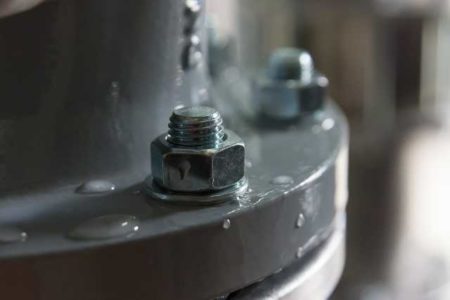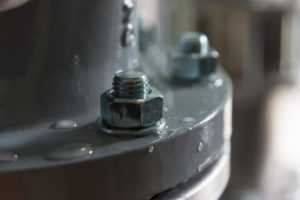 Here is the second installment of our “Why Do I Care” series. Every so often, we’ll blog about some of the questions people new to the gasket industry may be looking for more information on. The last installment was What Is Compressibility & Recovery, and Why Do I Care?.
Here is the second installment of our “Why Do I Care” series. Every so often, we’ll blog about some of the questions people new to the gasket industry may be looking for more information on. The last installment was What Is Compressibility & Recovery, and Why Do I Care?.
This week, we’re going to talk about bolt load. You may also have heard the terms: torque load, flange load, or compressive force, which all refer to the same thing. Bolt load is something to keep in mind when you are designing your joint and selecting your gasket material. Without knowing or paying attention to it, you may be setting yourself up for an insufficient load situation…and a problem.
Bolt Load
Putting it simply, bolt load is the key to the joint. Sufficient load must be available to achieve the initial seal, and then maintain that seal long-term over the life of the joint. The load must be comfortably more than needed, to overcome obstacles so a sufficient safety factor is present.
Achieving the proper load isn’t something that simply happens by grabbing a wrench and tightening the bolts until they feel snug. There is a lot that goes into the calculation and subsequently, the assembly, to ensure that the joint will stay properly sealed.
Bolt loading is not only the sum of the force from all of the fasteners, but also how it is applied and the geometry of how it is applied. Generally, the bolts should be placed such that they distribute the load evenly throughout the sealing surface and in line with it as best as possible (bolt circle).
Load is divided by sealing area to determine average flange load and thus target loading. This can be correlated to material studies so the engineer can make a determination of how much load is needed, and thus, how many bolts, what size bolts, and the torque to apply. Manufacturers will tell you that fasteners should be sized and loaded just before, at, or just after yield strength to apply the most load properly. This is also the reason they should not be reused, such as in a head gasket application.
Loading issues such as these are a key component in FEA (finite element analysis) and should be as accurate as possible to make a good model. Engineering evaluations such as this are often very helpful in establishing a successful design.
Gasket Material Makes A Difference
Bolt load is only as good as the compressibility and recovery your particular gasket material can achieve. One can figure out the perfect design and exactly what bolt load is needed in your application. But, if you don’t have the right gasket material (either because a poor selection was made, or there isn’t really a “right” material for your application because of how it was designed…oops), you aren’t going to achieve the seal that you need. Selecting the proper gasket material to meet your requirements is probably one of the more important pieces of the design, and the sooner in the design process you do this, the better off you’ll be.
Now That You Know
As you can see, bolt load is something that generally falls within the scope of a design engineer, but a good gasket material supplier can be a great resource. If you are unable to achieve the proper load, or you want to ensure that there a material to meet your loading requirements, talk with your supplier. They should be able to give you some insight, and maybe even a different material to consider.
What are some of the main reasons for your insufficient load problems? If you are interested in subscribing to Sealed-In’s blog posts, email sales@mtigasket.com.

Here is the second installment of our “Why Do I Care” series. Every so often, we’ll blog about some of the questions people new to the gasket industry may be looking for more information on. The last installment was What Is Compressibility & Recovery, and Why Do I Care?.
This week, we’re going to talk about bolt load. You may also have heard the terms: torque load, flange load, or compressive force, which all refer to the same thing. Bolt load is something to keep in mind when you are designing your joint and selecting your gasket material. Without knowing or paying attention to it, you may be setting yourself up for an insufficient load situation…and a problem.
Bolt Load
Putting it simply, bolt load is the key to the joint. Sufficient load must be available to achieve the initial seal, and then maintain that seal long-term over the life of the joint. The load must be comfortably more than needed, to overcome obstacles so a sufficient safety factor is present.
Achieving the proper load isn’t something that simply happens by grabbing a wrench and tightening the bolts until they feel snug. There is a lot that goes into the calculation and subsequently, the assembly, to ensure that the joint will stay properly sealed.
Bolt loading is not only the sum of the force from all of the fasteners, but also how it is applied and the geometry of how it is applied. Generally, the bolts should be placed such that they distribute the load evenly throughout the sealing surface and in line with it as best as possible (bolt circle).
Load is divided by sealing area to determine average flange load and thus target loading. This can be correlated to material studies so the engineer can make a determination of how much load is needed, and thus, how many bolts, what size bolts, and the torque to apply. Manufacturers will tell you that fasteners should be sized and loaded just before, at, or just after yield strength to apply the most load properly. This is also the reason they should not be reused, such as in a head gasket application.
Loading issues such as these are a key component in FEA (finite element analysis) and should be as accurate as possible to make a good model. Engineering evaluations such as this are often very helpful in establishing a successful design.
Gasket Material Makes A Difference
Bolt load is only as good as the compressibility and recovery your particular gasket material can achieve. One can figure out the perfect design and exactly what bolt load is needed in your application. But, if you don’t have the right gasket material (either because a poor selection was made, or there isn’t really a “right” material for your application because of how it was designed…oops), you aren’t going to achieve the seal that you need. Selecting the proper gasket material to meet your requirements is probably one of the more important pieces of the design, and the sooner in the design process you do this, the better off you’ll be.
Now That You Know
As you can see, bolt load is something that generally falls within the scope of a design engineer, but a good gasket material supplier can be a great resource. If you are unable to achieve the proper load, or you want to ensure that there a material to meet your loading requirements, talk with your supplier. They should be able to give you some insight, and maybe even a different material to consider.
What are some of the main reasons for your insufficient load problems? If you are interested in subscribing to Sealed-In’s blog posts, email sales@mtigasket.com.

Here is the second installment of our “Why Do I Care” series. Every so often, we’ll blog about some of the questions people new to the gasket industry may be looking for more information on. The last installment was What Is Compressibility & Recovery, and Why Do I Care?.
This week, we’re going to talk about bolt load. You may also have heard the terms: torque load, flange load, or compressive force, which all refer to the same thing. Bolt load is something to keep in mind when you are designing your joint and selecting your gasket material. Without knowing or paying attention to it, you may be setting yourself up for an insufficient load situation…and a problem.
Bolt Load
Putting it simply, bolt load is the key to the joint. Sufficient load must be available to achieve the initial seal, and then maintain that seal long-term over the life of the joint. The load must be comfortably more than needed, to overcome obstacles so a sufficient safety factor is present.
Achieving the proper load isn’t something that simply happens by grabbing a wrench and tightening the bolts until they feel snug. There is a lot that goes into the calculation and subsequently, the assembly, to ensure that the joint will stay properly sealed.
Bolt loading is not only the sum of the force from all of the fasteners, but also how it is applied and the geometry of how it is applied. Generally, the bolts should be placed such that they distribute the load evenly throughout the sealing surface and in line with it as best as possible (bolt circle).
Load is divided by sealing area to determine average flange load and thus target loading. This can be correlated to material studies so the engineer can make a determination of how much load is needed, and thus, how many bolts, what size bolts, and the torque to apply. Manufacturers will tell you that fasteners should be sized and loaded just before, at, or just after yield strength to apply the most load properly. This is also the reason they should not be reused, such as in a head gasket application.
Loading issues such as these are a key component in FEA (finite element analysis) and should be as accurate as possible to make a good model. Engineering evaluations such as this are often very helpful in establishing a successful design.
Gasket Material Makes A Difference
Bolt load is only as good as the compressibility and recovery your particular gasket material can achieve. One can figure out the perfect design and exactly what bolt load is needed in your application. But, if you don’t have the right gasket material (either because a poor selection was made, or there isn’t really a “right” material for your application because of how it was designed…oops), you aren’t going to achieve the seal that you need. Selecting the proper gasket material to meet your requirements is probably one of the more important pieces of the design, and the sooner in the design process you do this, the better off you’ll be.
Now That You Know
As you can see, bolt load is something that generally falls within the scope of a design engineer, but a good gasket material supplier can be a great resource. If you are unable to achieve the proper load, or you want to ensure that there a material to meet your loading requirements, talk with your supplier. They should be able to give you some insight, and maybe even a different material to consider.
What are some of the main reasons for your insufficient load problems? If you are interested in subscribing to Sealed-In’s blog posts, email sales@mtigasket.com.
